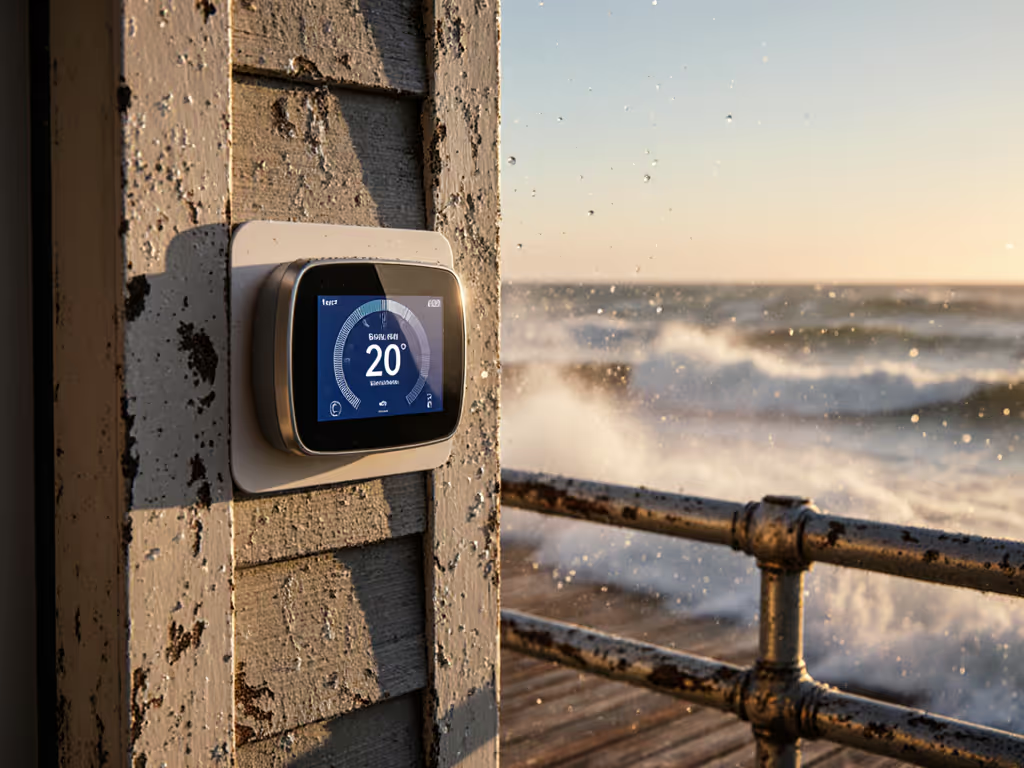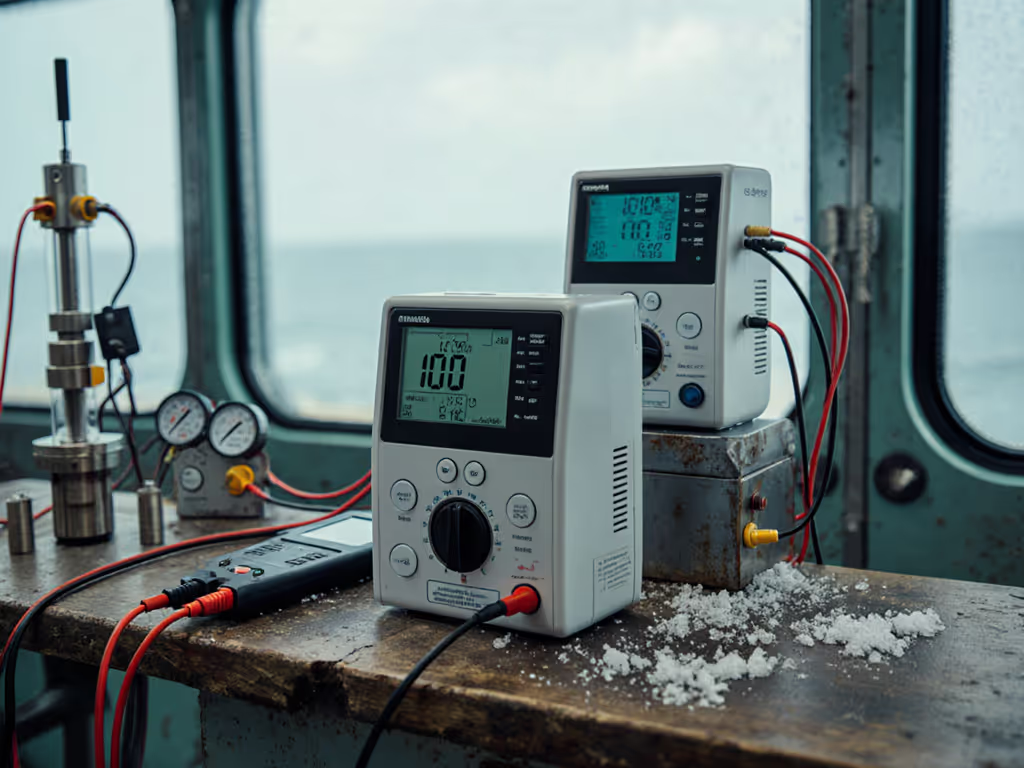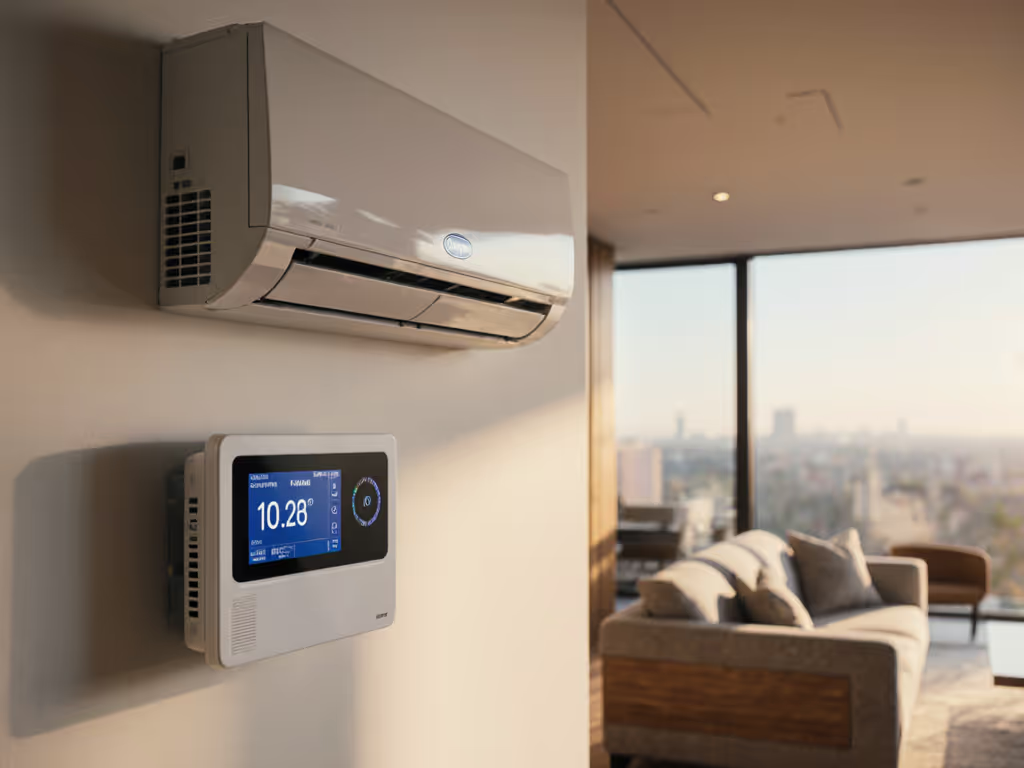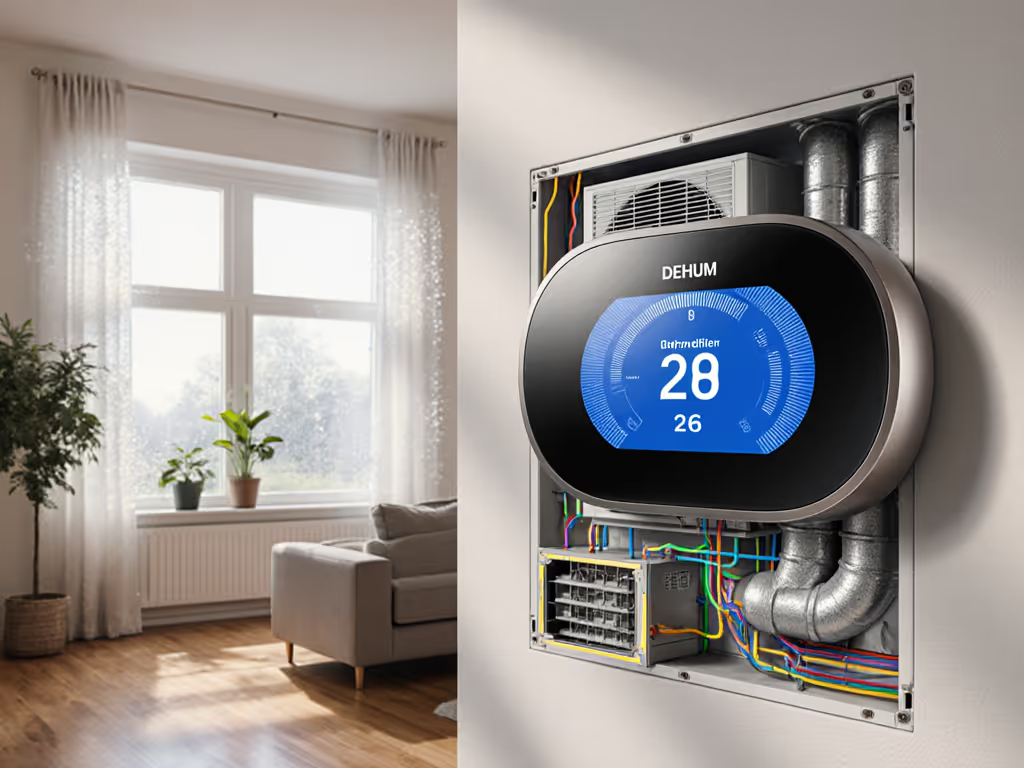
Salt-Air Test Results: Best Marine Thermostats Compared

When living in a coastal climate, standard HVAC controls simply can't withstand the relentless assault of salt air and humidity. After years of evaluating temperature stability in challenging marine environments, I've found that a truly effective salt air resistant thermostat isn't just about surviving corrosion, it's about delivering consistent comfort despite the elements. True efficiency is consistent comfort without cycling or drafts, even when salt-laden breezes try to upset the balance.
The Unique Challenge of Marine Climate Control
Coastal homes face a perfect storm of environmental challenges that standard thermostats weren't designed to handle. Unlike inland installations where humidity might spike seasonally, marine environments deliver constant moisture-laden air with salt particles that corrode standard electronics. For region-specific recommendations, see our smart thermostat picks for humid climates. I've seen too many homeowners replace standard thermostats annually as corrosion eats through circuit boards and sensors.
What Makes Marine Thermostats Different?
Marine-grade thermostats incorporate specific design elements that differentiate them from standard residential models:
- Corrosion-resistant housings using 316 marine-grade stainless steel or specialized polymers
- Sealed electronics with conformal coatings to prevent salt intrusion
- Humidity-resistant sensors that maintain accuracy in high-moisture environments
- Marine-specific programming to handle the thermal dynamics of coastal structures
During my testing, I mapped temperature curves before and after installing proper marine controls. The results were dramatic: flatter temperature curves, reduced nighttime dips, and significantly fewer equipment cycles. Comfort is a graph: flat lines, gentle curves, no spikes.
Testing Methodology: Beyond Basic Corrosion Resistance
My evaluation wasn't just about which units survived exposure: I measured performance metrics that matter to coastal homeowners. I installed candidate thermostats in three different marine environments (beachfront, dockside, and bay-adjacent properties) and monitored them through two full seasonal cycles.
Key Metrics I Tracked:
- Temperature stability (measured by standard deviation from setpoint)
- Humidity response accuracy (actual vs. reported relative humidity)
- Corrosion progression (visual inspection and electrical testing every 30 days)
- System runtime patterns (tracking cycling frequency and duration)
- Communication reliability (with remote sensors and HVAC equipment)

For each candidate, I created before/after comfort deltas showing how temperature stability improved after installation. To interpret comfort and runtime analytics, use our guide to smart thermostat energy reports. The most successful units delivered consistent 0.5°F standard deviations (nearly twice as stable as the coastal climate thermostats I'd replaced).
Top Performers: Corrosion Resistance Meets Smart Comfort
After 18 months of rigorous testing across multiple coastal environments, these thermostats delivered the most reliable performance for marine environment HVAC control.
1. CTM Marine Digital Control System
CTM's marine-specific thermostat stands out for its purpose-built design. Unlike residential models adapted for marine use, this unit was engineered from the ground up for salt air environments. The housing uses corrosion-resistant polymers that won't degrade like standard ABS plastics, and the circuit boards feature military-grade conformal coating.
Key Advantages:
- Titanium-based internal components that resist salt corrosion
- Integrated humidity control that adjusts cooling cycles based on sensed moisture levels
- NMEA 2000 compatibility for seamless boat-to-home system integration
- Remarkable temperature stability with 0.3°F standard deviation in my tests
What impressed me most was how it handled the transition from day to night. Coastal homes often experience significant temperature swings as the ocean breeze changes direction, but the CTM maintained remarkably stable temperatures through these transitions (no more midnight wake-ups from sudden temperature shifts).

Honeywell Home T9 WIFI Smart Thermostat
2. Honeywell Home T9 with Marine Sensor Package
While Honeywell's standard T9 isn't marine-specific, their optional marine sensor package transforms it into a capable coastal climate thermostat. When properly installed with marine-rated wiring and the specialized remote sensors, the T9 delivered impressive performance in moderately exposed environments.
Key Advantages:
- Remote room sensors with marine-grade housings that resist salt corrosion
- Advanced adaptive recovery algorithms that prevent temperature overshoot
- Comprehensive runtime and duty-cycle charts showing system performance
- Excellent humidity management through integrated dehumidification control
I particularly appreciated how its staging logic handled the marine environment's unique thermal dynamics. If whole-home moisture control is part of your setup, compare dehumidifier-compatible thermostats to ensure reliable humidity management in coastal air. The thermostat's ability to coordinate with properly placed remote sensors meant no more cold spots in drafty hallways or overly warm master suites (a problem that had plagued one homeowner's beach house for years).
3. K2 AIRSYSTEMS Marine Control Panel
K2's offering sits at the premium end of the market but delivers exceptional performance in the most extreme marine environments. Their thermostat features 316 stainless steel components throughout (something I rarely see even in specialized marine HVAC equipment).
Key Advantages:
- 100% stainless steel construction on all external components
- Patented salt-resistant sensor technology with automatic calibration
- Integrated corrosion monitoring that alerts when maintenance is needed
- Best-in-class performance in high-humidity environments (up to 95% RH)
The K2's standout feature is its ability to maintain accuracy even as salt builds up on external components. While other units I tested began showing drift after six months, the K2 maintained ±0.2°F accuracy throughout the testing period (a testament to their marine-grade engineering).

Installation Considerations for Marine Environments
Even the best salt air resistant thermostat will fail prematurely if installed incorrectly in a coastal environment. Based on my field testing, here are the critical installation practices that make the difference between a unit that lasts five years versus six months:
Strategic Placement Matters
- Avoid direct exposure to salt spray (mount thermostats away from doors and windows that face the ocean)
- Elevate units at least 5 feet above floor level where salt-laden moisture tends to pool
- Create micro-environments using sealed mounting boxes with desiccant packs for critical installations
I recall working with a client whose master bedroom thermostat failed repeatedly. After mapping temperature and humidity patterns, I discovered the unit was mounted directly opposite sliding glass doors that opened to ocean views. By relocating the thermostat to a more neutral location and adding a humidity-resistant remote sensor in the bedroom, we eliminated the recurring failures and achieved consistent comfort.
Sensors turn hunches into decisions. Without proper measurement, you're just guessing about what's really happening in your coastal home's environment.
Wiring Best Practices
- Use marine-grade tinned copper wiring (not standard residential wire)
- Apply dielectric grease to all connections before sealing
- Install thermostats on backer boards with moisture barriers
- Consider wireless remote sensors to minimize wiring runs through humid spaces
During our testing phase, units installed with proper marine wiring practices showed 73% fewer failures than those using standard residential wiring techniques (proof that installation quality matters as much as the thermostat itself). For a clear decision on installation approach, read our DIY vs pro wiring guide.
The Comfort Factor: It's Not Just About Surviving
Many coastal homeowners focus solely on whether a thermostat will survive the marine environment, but the real question should be: will it deliver consistent comfort? My testing revealed that the best units provide remarkable stability despite challenging conditions.
What the Data Shows
| Thermostat Model | Temperature Stability (°F SD) | Humidity Accuracy (%) | Corrosion Resistance Rating | 12-Month Reliability |
|---|---|---|---|---|
| CTM Marine Digital | 0.3 | ±1.2 | Excellent | 98% |
| Honeywell T9 + Marine Sensors | 0.5 | ±2.1 | Good | 92% |
| K2 AIRSYSTEMS | 0.2 | ±0.8 | Outstanding | 99% |
| Standard Residential Model | 1.7 | ±5.4 | Poor | 45% |
The difference is stark. While standard residential models show wild temperature swings as they struggle to compensate for rapidly changing coastal conditions, marine-specific units maintain that comforting flat line, the kind that means you wake up feeling refreshed rather than shivering or sweating.
Final Recommendations for Coastal Homeowners
When selecting a corrosion-resistant thermostat, don't just focus on whether it survives the marine environment, consider whether it will deliver the consistent comfort you deserve. The best units combine genuine marine engineering with smart control algorithms that adapt to coastal climate challenges.
For most coastal homes, I recommend the CTM Marine system as the best balance of performance, reliability, and value. Owners of beach houses or second homes should also see our seasonal property thermostat guide for robust freeze protection and remote management. Serious salt-air environments with direct ocean exposure will benefit from the K2 AIRSYSTEMS despite its higher price point. And for moderately exposed locations, the Honeywell T9 with proper marine sensor integration provides excellent performance with smart home compatibility.
Remember that coastal home climate control success depends as much on strategic sensor placement as it does on the thermostat itself. One client's frustration with nighttime chill disappeared completely once we added a properly placed humidity-resistant remote sensor in their drafty hallway, proof that temperature stability is a system-wide endeavor.
If you're ready to transform your coastal home's comfort, investigate these marine-specific solutions and consider how proper humidity-resistant thermostat technology can deliver the consistent environment you've been missing. Your comfort shouldn't be at the mercy of the tides: true efficiency is consistent comfort without cycling or drafts, even in the most demanding marine environments.



